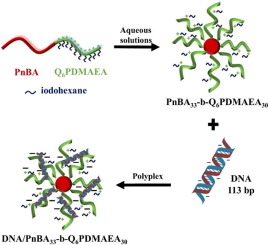当前位置:
X-MOL 学术
›
Eur. Polym. J.
›
论文详情
Our official English website, www.x-mol.net, welcomes your
feedback! (Note: you will need to create a separate account there.)
Hydrophilic/hydrophobic modifications of a PnBA-b-PDMAEA copolymer and complexation behaviour with short DNA
European Polymer Journal ( IF 5.8 ) Pub Date : 2020-04-01 , DOI: 10.1016/j.eurpolymj.2020.109636 Angeliki Chroni , Stergios Pispas
European Polymer Journal ( IF 5.8 ) Pub Date : 2020-04-01 , DOI: 10.1016/j.eurpolymj.2020.109636 Angeliki Chroni , Stergios Pispas

|
Abstract We present studies on the quaternization of poly[(n-butyl acrylate)-block-(2-dimethylamino)ethyl acrylate], PnBA40-b-PDMAEA60 diblock (where subscripts denote %wt composition of the components), synthesized by reversible addition fragmentation chain transfer (RAFT) polymerization, the self-assembly of the quaternized copolymers, as well as their capability in binding with a short nucleic acid. Methyl iodide (CH3I) and 1-iodohexane (C6H13I) are used for the quaternization of tertiary amines of the PDMAEA block. The quaternized PnBA21-b-Q1PDMAEA79 and PnBA33-b-Q6PDMAEA30 (where Q1 and Q6 prefixes denote the CH3I and C6H13I modifications) block polyelectrolytes are studied by fluorescence spectroscopy (FS) and their self-assembling behavior is investigated by dynamic and electrophoretic light scattering techniques (DLS and ELS). The PnBA21-b-Q1PDMAEA79 polyelectrolytes seem to self-assemble into small spherical micelles with a PnBA core in aqueous media, whereas a less well defined aggregation behavior is observed for the PnBA33-b-Q6PDMAEA30 copolymer, probably due to the presence of the six methylene hydrophobic side chains (C6H13) in the hydrophilic part of the copolymer, forming the micellar corona. The DNA binding capability of PnBA21-b-Q1PDMAEA79 and PnBA33-b-Q6PDMAEA30 chemically modified cationic block polyelectrolytes is studied and compared to the DNA complexation behaviour of the corresponding PnBA40-b-PDMAEA60 amino precursor. The formation and structure of polyplexes is studied by DLS, ELS, FS and UV–Vis techniques at various N/P ratios of positively-chargeable polymer amine (N = nitrogen) groups to negatively-charged nucleic acid phosphate (P) groups. The mass, size and surface potential of the polyplexes present a strong dependence on the N/P ratio. The stability of the polyplexes is determined by changes in their hydrodynamic parameters in the presence of salt. The PnBA33-b-Q6PDMAEA30 quaternized copolymer exhibits a more effective binding with DNA, presumably due to the existence of both electrostatic interactions and reinforced hydrophobic interactions between Q6PDMAEA chains and DNA base pairs.
中文翻译:

PnBA-b-PDMAEA 共聚物的亲水/疏水修饰和与短 DNA 的络合行为
摘要 我们介绍了聚[(丙烯酸正丁酯)-嵌段-(2-二甲氨基)乙基丙烯酸酯],PnBA40-b-PDMAEA60 二嵌段(其中下标表示组分的 %wt 组成)的季铵化研究,通过可逆加成合成断裂链转移 (RAFT) 聚合、季铵化共聚物的自组装,以及它们与短核酸结合的能力。甲基碘 (CH3I) 和 1-碘己烷 (C6H13I) 用于 PDMAEA 嵌段的叔胺的季铵化。通过荧光光谱 (FS) 研究季铵化 PnBA21-b-Q1PDMAEA79 和 PnBA33-b-Q6PDMAEA30(其中 Q1 和 Q6 前缀表示 CH3I 和 C6H13I 修饰)嵌段聚电解质,并通过动态和电泳光散射研究它们的自组装行为技术(DLS 和 ELS)。PnBA21-b-Q1PDMAEA79 聚电解质似乎在水性介质中自组装成具有 PnBA 核的小球形胶束,而观察到 PnBA33-b-Q6PDMAEA30 共聚物的聚集行为不太明确,这可能是由于存在六个共聚物亲水部分的亚甲基疏水侧链 (C6H13),形成胶束冠。研究了 PnBA21-b-Q1PDMAEA79 和 PnBA33-b-Q6PDMAEA30 化学修饰的阳离子嵌段聚电解质的 DNA 结合能力,并将其与相应的 PnBA40-b-PDMAEA60 氨基前体的 DNA 复合行为进行了比较。复合物的形成和结构通过 DLS、ELS、FS 和 UV-Vis 技术在带正电的聚合物胺(N = 氮)基团与带负电的核酸磷酸(P)基团的各种 N/P 比率下进行研究。复合物的质量、尺寸和表面电位对 N/P 比有很强的依赖性。聚合物复合物的稳定性取决于它们在盐存在下的流体动力学参数的变化。PnBA33-b-Q6PDMAEA30 季铵化共聚物与 DNA 的结合更有效,这可能是由于 Q6PDMAEA 链和 DNA 碱基对之间存在静电相互作用和增强的疏水相互作用。
更新日期:2020-04-01
中文翻译:

PnBA-b-PDMAEA 共聚物的亲水/疏水修饰和与短 DNA 的络合行为
摘要 我们介绍了聚[(丙烯酸正丁酯)-嵌段-(2-二甲氨基)乙基丙烯酸酯],PnBA40-b-PDMAEA60 二嵌段(其中下标表示组分的 %wt 组成)的季铵化研究,通过可逆加成合成断裂链转移 (RAFT) 聚合、季铵化共聚物的自组装,以及它们与短核酸结合的能力。甲基碘 (CH3I) 和 1-碘己烷 (C6H13I) 用于 PDMAEA 嵌段的叔胺的季铵化。通过荧光光谱 (FS) 研究季铵化 PnBA21-b-Q1PDMAEA79 和 PnBA33-b-Q6PDMAEA30(其中 Q1 和 Q6 前缀表示 CH3I 和 C6H13I 修饰)嵌段聚电解质,并通过动态和电泳光散射研究它们的自组装行为技术(DLS 和 ELS)。PnBA21-b-Q1PDMAEA79 聚电解质似乎在水性介质中自组装成具有 PnBA 核的小球形胶束,而观察到 PnBA33-b-Q6PDMAEA30 共聚物的聚集行为不太明确,这可能是由于存在六个共聚物亲水部分的亚甲基疏水侧链 (C6H13),形成胶束冠。研究了 PnBA21-b-Q1PDMAEA79 和 PnBA33-b-Q6PDMAEA30 化学修饰的阳离子嵌段聚电解质的 DNA 结合能力,并将其与相应的 PnBA40-b-PDMAEA60 氨基前体的 DNA 复合行为进行了比较。复合物的形成和结构通过 DLS、ELS、FS 和 UV-Vis 技术在带正电的聚合物胺(N = 氮)基团与带负电的核酸磷酸(P)基团的各种 N/P 比率下进行研究。复合物的质量、尺寸和表面电位对 N/P 比有很强的依赖性。聚合物复合物的稳定性取决于它们在盐存在下的流体动力学参数的变化。PnBA33-b-Q6PDMAEA30 季铵化共聚物与 DNA 的结合更有效,这可能是由于 Q6PDMAEA 链和 DNA 碱基对之间存在静电相互作用和增强的疏水相互作用。











































 京公网安备 11010802027423号
京公网安备 11010802027423号